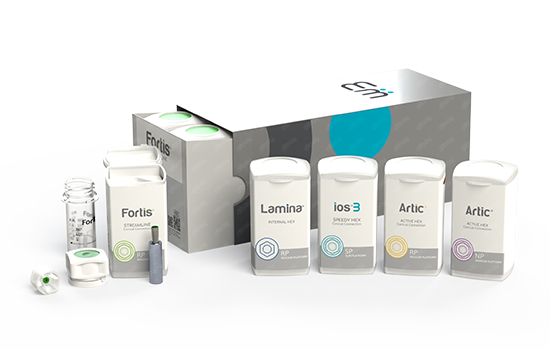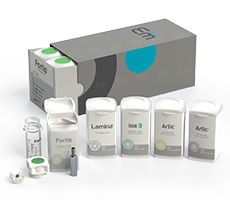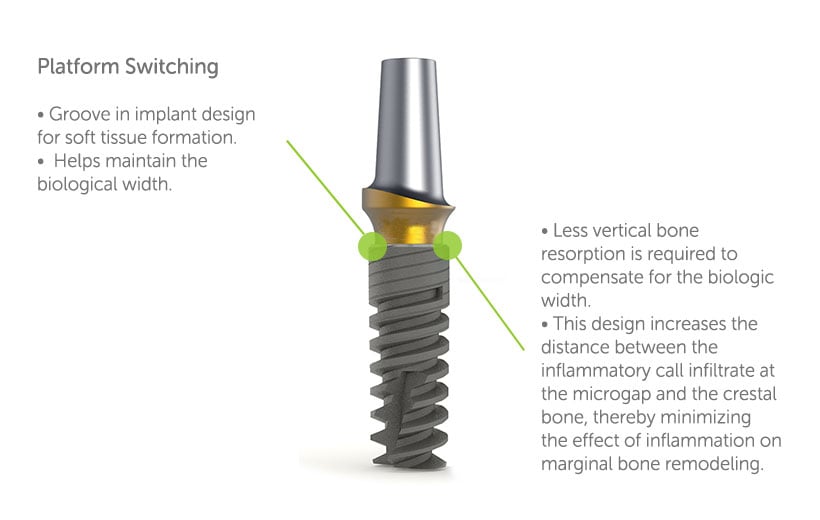Platform switching was discovered like many other great things, by accident.In the late 1980’s there were many instances
High Quality Dental Implant Components - Edison Medical™


Dental Implants
Available with an internal hex or conical connection.
A single implant design with universal compatibility and countless restoration opportunities.
Edison Medical’s implant lines
With across-brand usability being one of the foundation principles at Edison Medical, we have designed a single unique dental implant that is designed for use with four different connection types and more than 50 implant systems. All of EM’s implants are produced using sandblasted, large-grit, acid-etched (SLA) Ti-6AL-4V-ELI titanium alloy. Each ergonomically packaged implant features a mountless design and comes with its own surgical kit. Read about Edison Medical’s four connections and the implant systems they are fitted for use with below.
Lamina® Implant
Our Lamina® implants feature an internal hex connection, which is one of the more popular and well-known connections on the market, and is available in three different diameters, all of which have the same platform (RP 3.5) and hex size. The Lamina® line is designed for use with Zimmer®, BioHorizons®, Alpha Bio®, Implant Direct® (Legacy), MIS®, and Adin® implants, plus many more.
Fortis® Implant
The Fortis® implant line features a conical connection and across-brand usability with Osstem® & Hiossen® implants. This implant is available in three diameters, from 3.5 to 5.0mm, with the same connection size and platform for an easy and convenient workflow.
Artic® Implant
The Artic® implant features a conical connection and is designed for use with the Nobel Biocare® NobelActive® line. This line and Edison Medical’s Artic® implant line both feature two different platform options, NP (narrow platform) 3.5 and RP (regular platform) 4.3/5.0.
iOS3® Implant
The iOS3® line is Edison Medical’s slim implant line, with a diameter of 3.1 mm, and featuring a conical connection. This line is fitted for use with Astra® Tech OsseoSpeed™ RP 3.5/4.0, which is considered to be the best connection available for narrow neck implants, allowing to maintain and keep the thickest implant walls.
Unwavered quality: What to expect from an Edison Medical implant
- Mountless implant that is seated inside a titanium sleeve
- Simplicity and ease of use with such features as color coding, curved passive apex design and rapid/safe insertion
- Built-in platform switching
- Crestal bone loss prevention and reduced bone stress and resorption
- Superior geometric design featuring micro rings, dual threads and progressive threads
- Immediate initial stability
- Sand-blasted, large-grit, acid-etched (SLA) implant surface
- Sterile, quality-controlled manufacturing and packaging
A background of the dental implant
The dental implant is a small screw that is inserted into the patient’s alveolar bone, and it serves as the foundation and support of the dental prosthetic system, replacing the original dental root. Not only is the implant’s role in the prosthetic system crucial from a mechanical standpoint (think ability to withstand force and micromovements), but also in terms of durability and biocompatibility. When an implant is placed, we want that implant to perform in the patient’s mouth as would a natural tooth, and to last even longer. These characteristics sought from a dental implant can only be attained using the finest quality raw materials and by employing meticulous and state of the art design and production processes, which is the inherent foundation of every Edison Medical implant.
Titanium: The ultimate material for your dental implant
Titanium was first identified for its impressive physical properties by the aerospace industry in the 1950’s, where it was employed as a reliable workhorse material for its numerous benefits as a base material: light weight, high strength-to-weight ratio, and high resistance to corrosion. Over the decades, titanium gained popularity across a range of markets, particularly in the dental industry, where it is one the most commonly used materials. Titanium’s previously mentioned properties make it an ideal base and support of prosthetic systems, and is therefore the material of choice in Edison Medical’s implant lines. Titanium has additional qualities that make it ideal for long-term placement in the oral environment, such as excellent mechanical properties and high biocompatibility.
The dental implant surface
The relationship of an implant’s surface to the osteotomy site is a key determining factor in the implant’s mechanical stability. Osseointegration potential is affected by surface roughness, which can be applied to the implant surface by either chemical (acid etching) or mechanical (particle blasting) treatment. Sufficient and precise roughness provides an implant microsurface that maximizes likelihood of implant success and minimizes osseointegration time. The implant microsurface is also modifiable at the nano level, where hydrophilic and osteoconductive surfaces are created, and in turn better osseointegration is promoted by way of active ion interaction with blood plasma. The macrogeometry of the implant surface also has a considerable impact on implant success, as thread pitch and thread pattern both influence the quantity of bone around the implant site, as well as the degree of bone apposition onto the implant threads.
The Edison Medical implant surface
Edison Medical’s production process starts with the use of pure, high quality titanium, and employs a combination of large-grit sandblasting to prepare primary surface roughness, with subsequent acid-etching (SLA) to clear residual sandblast particles and generate a secondary roughness. The result is a composition of micro- and nano-surface structures that facilitate optimal bone adhesion and maximized success rate of each implant.
Connection types
The three connection types that Edison Medical offers are the internal hex, conical and a connection designed for use with the CrossFit® implant system. While there are other connection types to choose from (e.g. external hex, trilobe, conical with double hex, etc.), we stand behind these three connections due to their popularity, high success rates and because we see them as the three connections representative of the best the market has to offer. All of our connections are capable of platform-switching, which has been found to promote crestal bone loss preservation, as well as improve soft tissue health by creating a peri-implant soft tissue barrier, which also yields an improved esthetic result and a natural seal against bacterial infiltration.
Internal hex connection
The evolutionary step in implant-abutment connections following the external hex was the internal hex connection. Unlike the external hex, the internal hex, as indicated by its name, features a connection that sits inside the implant, the result being an implant system that can be placed at or below bone level. Naturally this design holds several advantages over the external hex, firstly with a considerable rise in implant stability. Other advantages include lower occurrence of screw loosening, strengthened joints, improved microbial seal, and better esthetic outcome. The system is not, however, devoid of disadvantages; the bone, rather than the retaining screw, bears the weight of the lateral forces in this system. With years of micromovements, bone loss and subsequent implant loosening has been observed with the internal hex, which can lead to microgaps and risk of infection.
Conical connection
The conical connection has become one of the most popular connections due to improved results over its predecessors regarding the stability, fit, and seal performance with the abutment. Within the conical connection family resides the Morse taper connection, in which lower incidence of screw loosening has been observed as a result of increased friction between implant and abutment, causing breakdown of surface oxide layers and subsequent occurrence of cold welding. This type of connection has also exhibited a significant increase in the capacity to resist bending forces.
What is a dental implant?
A dental implant is a small screw that is inserted into the patient’s alveolar bone, and serves as the foundation and support of the dental prosthetic system, replacing the original dental root. Not only is the implant’s role in the prosthetic system crucial from a mechanical standpoint (think ability to withstand force and micromovements), but also in terms of durability and biocompatibility.








